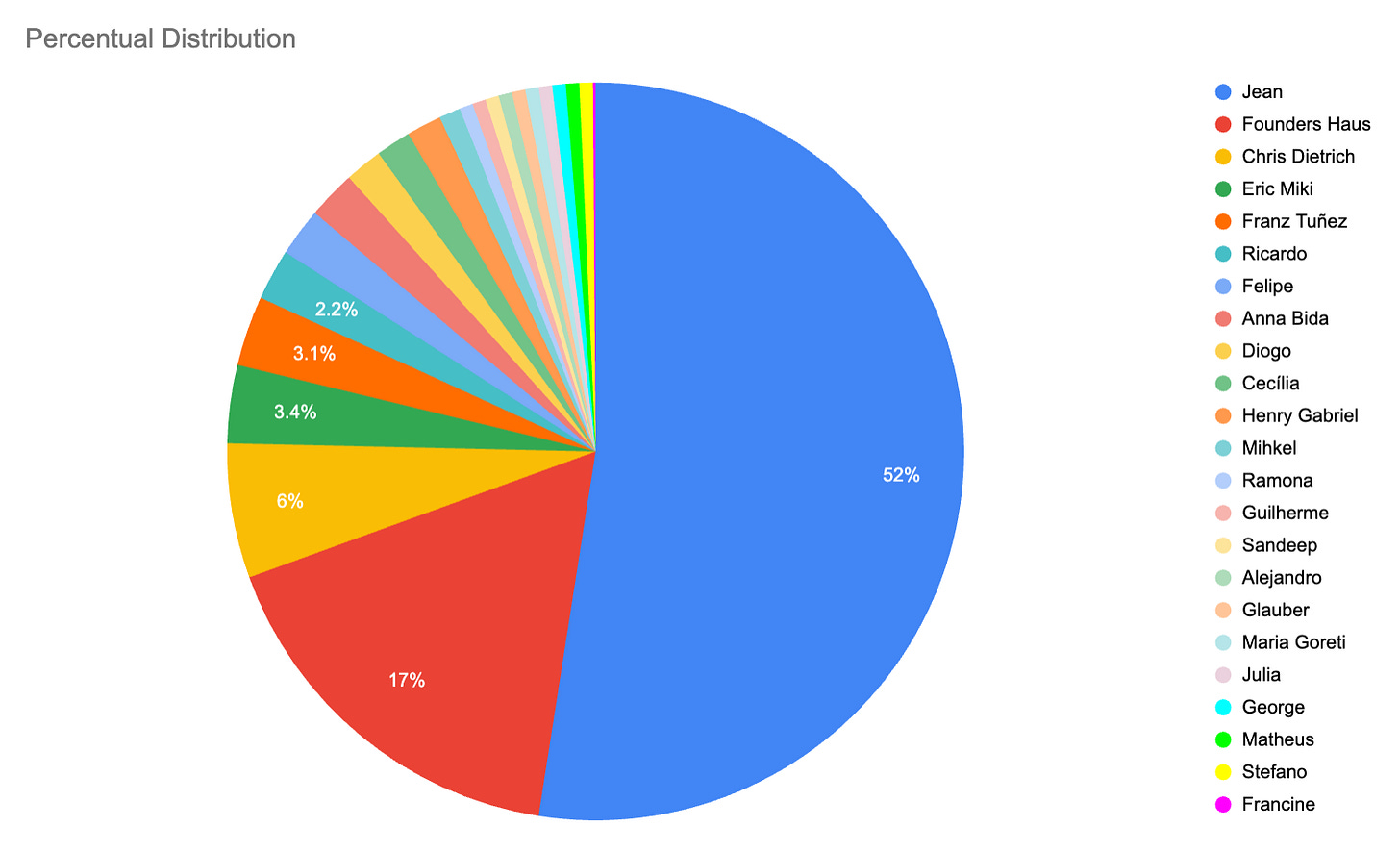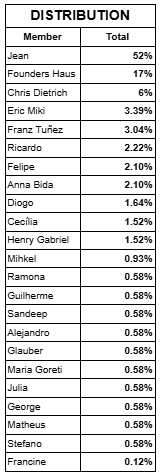Report: Ipê City, Implementing Valocracy in Brazil's First Pop-up City
The first of a series of open reports regarding Ipê Village Floripa
Report: Ipê City, Implementing Valocracy in Brazil's First Pop-up City
Ipê City was established in May 2025 as the first pop-up city in Brazil. Hosted in Jurerê Internacional, Florianópolis, the initiative relied on the infrastructure of Founder Haus and the founding vision of Jean Hansen.
The project was born with a primary purpose: to implement in practice the principles presented in the book The Network State by Balaji Srinivasan, creating a living space to experiment with new forms of decentralized governance, human coordination, and social innovation at a community scale.
Indirectly, the initiative also achieved complementary objectives, such as:
Providing a deeper environment for social and professional immersion than traditional events.
Experimenting with Valocracy, a governance model created by Rafael Castaneda.
Applying practical mechanisms for recognizing contributions and measuring collective value through the Rarity Calculator.
Governance Framework: Valocracy
Valocracy is a governance model that redefines the notion of political influence, replacing purchasing power with the value generated for the collective. In this regime, individuals are recognized according to their ability to contribute, not their ability to extract resources from the group.
The model aligns with the concept of crypto-history, where social experiments and contributions are recorded as blocks of learning that can be replicated, adapted, or improved in other contexts.
Implementation: The Rarity Calculator
Purpose
To operationalize Valocracy in Ipê City, the Rarity Calculator was developed as the main methodological tool during the experiment. Its purpose was to establish a proportional and transparent recognition system, capable of capturing both operational and strategic contributions.
Methodology and data collection
The calculation method was built from a combination of three sources:
Interviews with participants, to capture qualitative perceptions of effort and impact.
Collection of data from existing kanbans, documenting ongoing and completed activities, as well as using the form available at this link.
Extensive review and feedback sessions with members, ensuring collective alignment and legitimacy of criteria.
Each contribution was assessed using variables presented in the Playbook Valocracy Rarities Calculation, representing different dimensions of value for the collective. Below, the 5 aspects and their evaluated variables will be briefly explained, with the playbook containing all the details, as well as the calculation for converting points into rarities.
This multifactor analysis made it possible to translate subjective contributions into objective classifications, associated with different rarity categories.
Complete documentation for each member with all their respective deliverables is available for consultation in the following folder: link to drive
Rarity Levels
Contributions were grouped into 12 rarity levels, symbolically organized as a growth cycle:
Seeds: Common, Uncommon, Special
Trunk: Rare, Very Rare, Extraordinary
Flowers: Very Extraordinary, Epic, Very Epic
Roots: Elite, Legendary, Mythical
Aspects and Variables Assessed
Each contribution mapped in Ipê City was analyzed through a set of aspects and variables that made it possible to translate the complexity and impact of the deliverables into proportional metrics. This approach ensured that different forms of participation, from operational tasks to strategic roles, were recognized fairly.
The method was built from interviews, records in kanbans, and successive rounds of review and feedback with members, ensuring legitimacy through a collective process. The dimensions considered are described in the Playbook Valocracy Rarities Calculation and can be summarized in five axes:
1. Time and Effort
Measures the time invested, the urgency of the delivery, and the intensity of participation, recognizing that different contributions may demand varying levels of physical, mental, and emotional energy.
2. Technical Complexity
Assesses the level of specialized knowledge required and the degree of autonomy in execution. The greater the technical sophistication and independence to carry out the deliverable, the higher the weight assigned.
3. Assets Involved
Considers the resources used, shared, or put at risk, such as social capital, technological infrastructure, and financial value.
4. Impact and Transformation
Measures the relevance of the contribution to the collective and the ecosystem, including tangible results, strategic impact, interdependence with other areas, and the level of proactivity demonstrated.
5. Degree of Uncertainty
Reflects the exposure to risks and ambiguities, including the resolution of technical or operational problems, conflict mediation, and opportunity costs assumed during execution.
Together, these five axes form the foundation of the Rarity Calculator’s evaluation process, allowing contributions to be assigned different levels of recognition according to their relevance and impact in the collective context.
Indicators
During the first cycle of application, the Rarity Calculator recorded and analyzed 43 contributions made by 23 members. The final distribution of rarities was as follows:
The distribution shows that more than half of the contributions were concentrated in the Rare and Very Rare levels, typical of architecture, coordination, and project execution tasks with some complexity. At the same time, about one third of the contributions were classified at higher impact levels (Extraordinary to Epic), confirming the strong collective engagement.
Distribution and Deliverables by Member
The analysis of the weighted distribution of contributions shows that Jean accounted for 52 percent of the aggregated value, reflecting his founding and leadership role. Founder Haus follows with 16.8 percent, associated with infrastructure, hospitality, logistics, and the curation of the experiment. The remaining 31.2 percent was distributed among 21 contributors, confirming the diversity and multidisciplinary character of the core team.
Among the individual highlights are: Chris Dietrich (5.8 percent), Eric Miki (3.4 percent), Franz Tuñez (3.0 percent), Cecília from Lit Collective (2.5 percent), Ricardo (2.2 percent), Felipe (2.1 percent), Anna Bida (2.1 percent), Diogo (1.6 percent), Henry Gabriel (1.5 percent), and Mihkel (0.9 percent).
Here is the complete list:
This quantitative panorama is complemented by the qualitative mapping of deliverables, which highlights the diversity of functions and rarity levels:
Common and Special contributions were registered by Diogo and Francine, in administrative and community roles, and by Ricardo, who completed a conference project. Although these contributions had lower rarity, they ensured the operational foundation of the collective.
Rare contributions were primarily performed by architects (Alejandro, Anna Bida, Felipe, Franz Tuñez, George, Glauber, Guilherme, Julia, Maria Goreti, Ramona, Sandeep), as well as specific projects such as the Ipê Mind Tree Project (Matheus and Stefano) and organizational collaborations (Henry Gabriel). These 14 records formed the backbone of the city, translating the initial phase of construction and structuring.
Very Rare contributions highlighted roles of greater organizational complexity, such as the development of the Ipê website (Cecília – Lit Collective), product velocity coordination (Chris Dietrich), team collaboration during the pop-up (Henry Gabriel), Social and Communication roles (Ricardo), and collective projects (Eric Miki and Mihkel). These eight deliverables expanded the layer of governance and strategic support.
Extraordinary contributions included areas such as contribution mapping (Anna Bida), design and visual communication (Cecília – Lit Collective), project collaboration (Diogo), DAO setup and grants (Felipe), and branding and website conceptualization and support (Jean). These five records elevated the impact of contributions to a strategic level.
Very Extraordinary contributions involved logistical, strategic, and leadership support in highly relevant roles. These included the organization of the Regen House (Eric Miki and Franz Tuñez), event strategy and production (Founder Haus), and logistics and enablement during the pop-up (Jean). These five deliverables represented critical functions for collective execution.
Epic and Very Epic contributions highlighted high-impact deliverables such as the Super App prototype (Chris Dietrich), event strategy, promotion and operation (Founder Haus), as well as content production, media, and documentation (Jean). These six contributions were decisive in consolidating the identity and memory of the city.
Elite and Mythical contributions were concentrated in Jean, who took on the city’s founding, strategy, and leadership roles (Mythical), as well as business development, prospecting, and sales functions (Elite). These two deliverables symbolize the highest rarity levels, reflecting both the visionary role and the strategic backbone of the project.
This combination of percentages and deliverables shows that, while the founding leadership concentrated much of the value (Jean and Founder Haus), there was a broad base of collaborators who performed diverse functions, ranging from administrative activities to highly complex initiatives. The Rarity Calculator ensured that all these contributions were recorded and recognized proportionally to their collective impact, creating a transparent portrait of the dynamics of Ipê City.
Results
The Ipê City experience confirmed the practical applicability of Valocracy as a governance model in a community environment. Through the Rarity Calculator, it was possible to establish a proportional recognition system where each contribution was made visible and valued according to its relevance to the collective.
The process also reinforced interdisciplinary and intercultural collaboration. During the residency, people from different fields joined forces around common goals, strengthening the community’s social fabric and broadening the diversity of perspectives in the construction process.
Another important result was the consolidation of a replicable framework. The methodology validated in Florianópolis demonstrated that pop-up cities can become living laboratories capable of balancing technology, decentralized governance, and human engagement, leaving a legacy that extends beyond the in-person immersion and continues remotely.
Key Success Factors
The success of Ipê City was linked to a combination of decisive factors. The visionary leadership of Jean Hansen was crucial to create the conditions for experimentation, providing the infrastructure and the space that allowed the initiative to flourish.
The conceptual foundation offered by Rafael Castaneda, through Valocracy, gave consistency and clarity of purpose, enabling the community to follow a well-defined direction in its governance practices.
Another crucial element was the development of the Rarity Calculator by architect Anna Bida, which transformed previously abstract principles into concrete metrics, recognized and adopted by the community.
Finally, the active participation of 23 members was the vital element that gave shape to the experience. It was the plurality of their contributions that gave legitimacy to the process, allowing the methodology to be validated in practice and creating a collective memory that will serve as a reference for future initiatives.
Conclusion
Ipê City represented a milestone in the experimentation of new socioeconomic and governance models in Brazil. Its central objective, to test in practice the principles of The Network State, was achieved by creating a community environment where theory was transformed into lived experience.
By combining the theoretical inspiration of The Network State, the principles of Valocracy, and the practical application of the Rarity Calculator, the city became a true living laboratory.
The experience demonstrated that governance innovation can go beyond the conceptual field, being lived and tested collectively. Even after the in-person residency, Ipê City remains active remotely, validating the role of pop-up cities as catalysts of social innovation, cultural exchange, and decentralized coordination.






